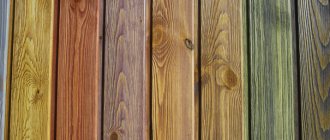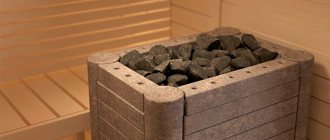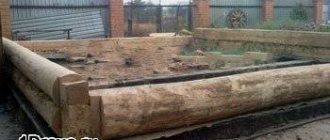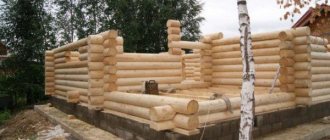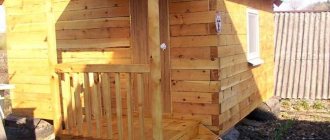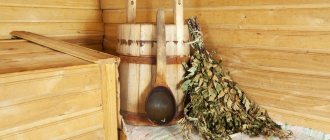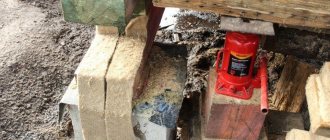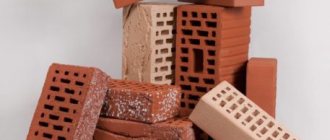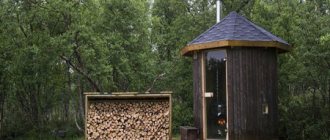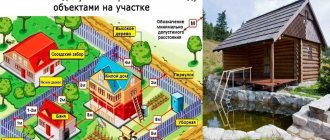The basement is the above-ground part of the house above the foundation. Its top mark is usually the floor mark of the 1st floor. It turns out that the base is part of the wall of the house that encloses the underground space.
The underground, basement or technical floor can be cold or warm. For the so-called warm underground, the base must be additionally insulated. But in this article we will consider a cold basement, because for a simple, seasonal bathhouse or a country house, there is no need for a warm underground.
How to make a strip foundation for a bathhouse with a brick base: device, installation
In this article we will look at a specific example of the construction of a strip foundation for a bathhouse with a brick base.
A strip foundation is a solid foundation erected under the wall of a building (structure). In Rus', the bathhouse has long been an indispensable attribute of both the peasant courtyard and the noble estate. Tsars, boyars, and commoners loved to take a steam bath in the bathhouse. Of course, the main purpose of the bath is sanitary and hygienic, but our ancestors were well aware of the health-improving functions of bath procedures, knew many secrets of enhancing the beneficial effects of bath steam, and used all kinds of herbs for steam, brooms, ointments, and teas. Even the following proverb was invented: “The day you take a steam bath, the day you don’t grow old!”
In addition to knowledge about the benefits and necessity of bathing and washing procedures, a hard-working Russian man could also build this very bathhouse with his own hands, which cannot be said about the majority of modern city residents, who in recent years, tired of the bustle and noise of megacities, are increasingly thinking about purchasing country houses, garden plots, or at least small dachas, but construction work is entrusted to third-party organizations and teams. After all, the townspeople themselves simply do not know either the old “old-fashioned” construction techniques or modern technologies.
Meanwhile, you can build a bathhouse yourself, according to your needs and capabilities, while significantly saving the family budget.
Before you start building a bathhouse, you need to think about its layout and placement on the site. You can see detailed information about this in our article on designing a bathhouse.
Having decided on the size of the building, you need to prepare the construction site, and you can begin building the foundation of the bathhouse. The foundation for a bathhouse can be columnar, strip or pile, including screw piles.
If you have chosen a strip foundation for your bathhouse, then our article will help you implement your project in the shortest possible time and with the lowest financial costs.
Partition in a wooden bath
This option is also quite possible. This solution is not particularly practical, so it is used mainly for design reasons. In this case there are two options:
- Made of facing bricks with a mandatory frame made of another material;
- Made of brick with a masonry thickness of one brick and on its own foundation.
Using facing bricks for an internal unplastered partition is more practical. Facing brick, especially if it is hollow, has low strength, so its masonry must be attached to some kind of foundation. A wooden frame structure is quite suitable.
A brick partition in a wooden bathhouse can be created with your own hands without special purchase of facing bricks. In this case, the masonry must be done in one brick, and the structure must be built on a stone or concrete foundation.
The thickness of one brick requires twice as much materials, but ordinary building bricks without external surface defects will do for them. Taking into account the price of facing bricks, a larger quantity of ordinary bricks can often cost less.
The choice of which brick is needed for the partition in the bathhouse is based on design and cost considerations. There is a great advantage to facing bricks. It comes in a wide variety of options.
In a wooden bathhouse, the thickness of the brick can be any. In a brick bath, it must match the dimensions of the main brick, which is used for laying the outer walls.
Stages of construction of a strip foundation for a summer residence
Place of construction of the strip foundation: summer cottage in a garden society.
Foundation dimensions: 6x6 m. Including: locker room (rest room) - 3x6m, sink - 3x4m, steam room - 2x3m.
Features of the building site: the previous owners of the site began to build a strip foundation on three sides along the perimeter of the bathhouse, the size of one side is 6 m, two sides are 4 m each, the width of the foundation is 300 mm, the height is 300 mm. Another important feature of this site is that at the time of construction work there was no possibility of connecting to electrical networks.
Task: to complete the remaining strip foundation (perimeter and under internal partitions).
1. Preparing the construction site. The building site must be cleared of debris and any foreign objects, the plant layer of soil must be removed, and the site must be leveled. 2. Layout of the site according to the planned plan. In order to set out the axes, a geodetic instrument, a theodolite, was used. Wooden pegs were installed along the perimeter of the future strip foundation and a cord was pulled. In the absence of a theodolite, we recall the Pythagorean theorem that in a right triangle the sum of the squares of the legs is equal to the square of the hypotenuse, take a tape measure and a cord, and make a breakdown. 3. Creation of a trench. In order to build a strip foundation, it is necessary to dig a trench, the depth of which can be individual, depending on the characteristics of the soil in the area. In our case, the site had previously been backfilled, so a layer of fertile soil was removed to a dense layer of sand, and the depth of the trench was 250 mm. When constructing a strip foundation, a layer of sand and a layer of crushed stone are poured into the trench; each layer can reach a thickness of 100 mm. But, since we did not need to pour a layer of sand, only crushed stone was filled in. 4. Arrangement of formwork. For the installation of formwork, a 50x150 mm board and reinforcement with a length of 700 mm and a cross-section of 14 mm were used. The reinforcement is driven vertically into the ground every 2-3 meters along the perimeter of the dug trench, then boards are installed along the edges. We nail a picket fence (bar) measuring 25x40 mm and 400-450 mm long on top. The distance between the bars is 1-1.5 m. After installing the formwork, we carry out leveling with a geodetic device - a level on a picket fence, and place “beacons” in the corners, using nails for this. 5. Laying reinforcement. It is necessary to lay reinforcement with a cross-section of 12-14 mm in the trench, 2 pieces on each side. The length of the reinforcement is calculated as follows: there should be 0.04 m left on each side; if the length of the wall is, for example, 6 m, then the length of the reinforcement is 5.92 m. You need to cut the reinforcement with an angle grinder (grinder), therefore, in the absence of electricity, this needs to be taken care of in advance. Since we had a part of the strip foundation poured, along the edges of which reinforcement outlets were left, the reinforcement was overlapped with steel tying wire. We place broken bricks under the reinforcement, the quantity can be any, the main thing is that the reinforcement does not sag. It is possible, of course, to perform longitudinal and transverse reinforcement, but this is usually performed when constructing foundations for heavier structures. For a light one-story bathhouse made of timber, there is no need for this kind of reinforcement; it will simply be an extra waste of metal. 6. Preparation of concrete mortar and its laying. The concrete mixture can be prepared mechanically, using a concrete mixer, or manually, mixing the composition in an iron container suitable for these purposes. In our case, the manual method was used, using a “solution jar” with a capacity of 0.13 cubic meters.
Brick plinth manufacturing technology
The most widely used insulation material is solid thermal insulation. This can be slab polystyrene foam, which has the best characteristics. It holds its shape perfectly, does not allow moisture to pass through, and is easy to install. Therefore, the question of whether to insulate the base with more traditional materials can be answered in the negative.
The base in the photo is insulated with extruded polystyrene foam.
We invite you to familiarize yourself with the features and advantages of a bathhouse made of foam blocks
Expanded polystyrene has different thicknesses - from 30 mm to 120 mm, so before you insulate the base, you first need to decide on the best option. It all depends on the climate zone in which the bathhouse is built: the colder it is, the thicker the insulation should be.
Insulation of the base with polystyrene foam occurs in several steps:
- Preparing the base. We clean the surface of the base from debris, and then thoroughly treat it with a primer.
- Preparation of polystyrene foam. Using a special knife, cut out the necessary pieces of material.
- Installation. On the prepared polystyrene foam we apply an adhesive mixture that does not contain harmful and flammable substances (bitumen-polymer mastic or polyurethane glue), and using a spatula with slots we level it over the entire surface. We apply a sheet of polystyrene foam to the base and, lightly tapping with our palms, achieve an even fit.
- Final works. After gluing the entire surface of the base, we seal the seams and putty the surface with a moisture-resistant mixture for external use.
- After insulation, the base must be given an aesthetic appearance. The cheapest thing would be to simply plaster it, but everyone, of course, wants to decorate the base to their own taste.
If you are thinking about whether to insulate the base yourself or call specialists to do this work, we advise you to contact our company or order a turnkey bathhouse in Kazan.
It will be interesting to read:
- How to attach a veranda to a bathhouse?
- Ventilation in the bathhouse is a necessity.
- How and with what to insulate the floor in a bathhouse?
Material selection
- clinker is the most durable of existing analogues, has a long service life, does not require finishing, is absolutely waterproof, but is too expensive, so it is rarely used;
- clay - more often called ordinary, has minimal aesthetics of perception, decoration is necessary, the material is chosen according to frost resistance (M 150 - M 250 for 50 - 100 seasons, respectively), this is a budget brick that allows you to reduce the construction budget;
- ceramics – average price, excellent decorative properties, solid and hollow modifications are available;
- porous - minimally loads the foundation structure, does not require cladding, is an improved analogue of ceramics, therefore costs more, there are large-format modifications with non-standard sizes;
- dry, semi-dry pressing - looks like ceramics, but does not fire, has lower frost resistance, is inexpensive, the masonry does not need lining;
Solid clay brick is the most suitable material for the plinth.
When choosing a brick other than the walls, the plinth by default becomes an independent element of the facade design.
To build a brick plinth, you will need a standard trowel, a level, a mooring, a plumb line, a cord, and a pick. When using facing bricks, cutting is best done with an angle grinder (grinder) with a diamond blade or stone equipment. For the solution you will need a bucket with a shovel or a bucket with a drill or mixer. Professionals can make do with a piece of roofing felt or a sheet of iron; it is better for a home craftsman not to risk the quality of the batches.
For facing masonry, special devices are produced that make it easier to level the pastels in each row. The only drawback of the Bricky device is its adaptation to foreign bricks, the dimensions of which are somewhat different from their domestic counterparts.
The brick plinth has a width depending on the type chosen (flush, protruding, recessed) and the thickness of the walls. For example, for a masonry of 51 cm, this value is in the range of 45-57 cm. There are options when the base is wider than the foundation - in this case, the release of brick on any side is limited to ¼ of its length (6 cm).
Due to the lack of regulatory documentation for the installation of the foot of the house, the brick plinth can be of any height. Experts do not recommend building it higher than half of the first floor - this will disrupt the architecture of the building and the exterior of the facades.
Without a project, only garden houses can be built; in all other cases, the necessary marks for all structures are included in the documentation. Self-builders solve the problem of foot height as follows:
- if the foundation is poured at ground level, choose a masonry height of 0.7-1 m;
- if a plinth is needed for a technical underground, they are guided by the dimensions of the engineering systems (usually pumping equipment, valves) that must fit in it;
- if a footstool is needed to complete the basement, choose a comfortable ceiling height in the lower level.
In the last two options, insulation is often placed into the base structure (if the brick is facing) or external insulation is performed, taking into account its thickness.
Unlike the external soil, the ground under the house does not freeze in any frost. It contains moisture absorbed by the concrete and transferred to the upper structures. Therefore, the foundation is necessarily cut off from them with a waterproofing layer.
In order to waterproof the foundation efficiently, it is enough to lay two layers of rolled material, a membrane or a film along its perimeter. The side surfaces of the concrete strip also need to be treated to protect against flood, groundwater, and melt water. In this case, deep penetration primers that change the structure of the material are much more effective.
The top waterproofing is laid overlapping at the joints, protrudes 2-3 cm beyond the perimeter, and is cut off upon completion of the masonry.
Composition of concrete mixture per 1 cubic meter. m.
- medium crushed stone (fraction 20-40 mm) - 1900 kg. clean sand (content 5%) - 1140 kg.
- Portland cement PC 500 - 380 kg.
- water (from a well or tap)
The required amount of concrete mixture can be easily calculated based on the size of the future strip foundation. In our case: height - 0.3 m, width - 0.3 m, length - 19 m (6+2+2+6+3). Therefore, we need V=0.3×0.3×19=1.71 cubic meters.
In our case, construction work was carried out when the air temperature at night dropped to minus 5°C, so we additionally used the anti-frost plasticizing additive “Benotech PMP - 1”, which is sold in liquid form. At temperatures from 0 to −5°C, it is necessary to add 1% additive by weight of cement to the concrete mixture. The amount is calculated based on the mass of dry matter, of which one liter of additive contains approximately 453.4 g. At 380 kg. Portland cement requires 8.38 liters. additives.
You can use another additive that accelerates the hardening of the concrete mixture and has antifreeze properties.
If it is possible to connect to the electrical network, the concrete structure can be heated using heating formwork, which uses heating cables, heating elements, mesh heaters and other heating elements. In addition, the concrete mixture can be heated to a temperature of 40-60 °C before laying.
Technology for preparing concrete mixture for strip foundations
The required amount of sand is poured into the container, a depression is made in it and cement is poured in, everything is thoroughly mixed with a shovel. Crushed stone is added to this mixture and mixed well again. Then water is gradually added, preferably from a watering can, so as not to wash away sand particles with a strong stream.
In the garden plot there may not be containers on hand to accurately measure the required amount of material, so buckets are often used for these purposes.
Amount of material in one bucket (10 l):
- crushed stone - 15-17 kg
- sand - 14-17 kg
- cement - 13-15 kg
The amount of crushed stone depends on its fraction, the amount of sand depends on humidity, and the amount of cement is affected by the density of its compaction during backfilling.
In what cases does insulation need to be used?
The base is insulated both from the outside and from the inside. It is necessary to insulate the base from the outside if:
- the floors in the bathhouse are not insulated enough;
- freezing of the foundation in winter was noticed;
- even after careful insulation of the walls and roof, a draft is felt in the rooms;
- They plan to use the bathhouse frequently and year-round;
- There is groundwater close to the base of the bathhouse.
We invite you to familiarize yourself with: Bathhouse with swimming pool and attic
Internal insulation will increase the protection of the base. It is much easier to insulate the base from the inside, because the inner surface of the base is not visible. It is enough to stick polystyrene foam on the base surface, secure the seams with reinforcing tape and perform some simple cladding.
Laying concrete mortar
- The finished solution is poured into the formwork, leveled, pierced with a probe or bayonet shovel (to remove excess air), and tapped from the outside of the formwork with a wooden hammer.
- If it is possible to connect to the electrical network, then an internal vibrator can be used to compact the concrete mixture.
- At sub-zero temperatures, the strip foundation is covered on top with a film and a layer of sawdust or any insulation.
- After three days, the formwork can be carefully removed.
Insulation process
Warming is the most important process. To prevent heat from escaping from the room, it is necessary to carefully protect the basement structure, including the foundation, using some kind of insulation. The choice and depth of installation of the selected insulation will depend on how deeply the soil freezes in a particular region. The walls are also insulated from the outside; for this, rigid polystyrene foam or special mineral wool is used using fiberglass mesh reinforcement and layers of waterproofing.
Strip foundation - work order
1. A layer of roofing felt (or other waterproofing material) is laid on the concrete foundation. Roofing material can be easily cut with a knife into strips of the required width. 2. For brickwork, a single-row (chain) ligation method was used. A layer of masonry mortar is laid on top of the waterproofing material, then, across the longitudinal axis of the foundation, a brick is laid to form a bonded row of masonry. We lay a masonry mesh on top of the first row of bricks. The second row of masonry is a spoon row (along the axis). 3. The number of rows of masonry will depend on the desired height of the strip foundation for the bathhouse. In our case, 4 rows of masonry were completed (see information on methods of masonry). 4. The required amount of brick is calculated as follows: the standard size of one brick is 250 × 120 × 65 mm, the length of the base is 35 m, two rows of masonry with a butt side are 120 mm each, two rows are 250 mm each, seams are 10 mm. We make a simple calculation: 3500×2:13+3500×2:26=807.69. Therefore, we will need approximately 808 bricks. 5. In the third row of masonry (bonded) it is necessary to make ventilation ducts. To do this, we use scraps of a metal or plastic pipe, which is mounted across the axis of the foundation in a horizontal position. The diameter of the pipe is not of fundamental importance; we used the one that was available. 5 vents were made for the entire foundation. 6. A row of masonry mesh is again laid on top of the third row of bricks, then the last row of bricks (spoon). 7. The final stage is the installation of a cement screed from a thick mortar 1:2-3. The recommended height of the cement screed is 20 mm. 8. Wait for the solution to dry completely.
That's all, our strip foundation has been successfully completed, and we can proceed to the next stage of building the bathhouse.
Reinforcement
Building load-bearing structures have a strength standard established by regulations. The bathhouse, even if it has only one floor, must comply with them. The strength of the brick, especially with a small masonry thickness, is often insufficient. In addition, in the event of an earthquake, even strong brickwork will quickly collapse. The solution is to use reinforcing belts.
Information. Armored belts began to be used by builders back in ancient Rome. The modern design of reinforcing belts differs little from them. Instead of forged steel rods, rolled steel is now used.
In terms of weight, steel reinforcement is much more expensive than brick and concrete, but its use allows you to save much larger volumes of material. If you make the walls of a bathhouse without any reinforcement at all, then they must be of considerable thickness. Two or two and a half bricks. Therefore, before building a brick bathhouse, be sure to provide reinforcing belts.
One of them must be located in the foundation, in a recessed position or on a plinth.
If the foundation is made of prefabricated concrete blocks, then additional reinforcement is not required.
It is also not needed for a monolithic slab. Strip and column foundations cannot be built without reinforcement.
The second reinforcing belt is laid at the top of the walls. In construction it is called a seismic belt. Such belts perform a dual function: they keep the walls from collapsing in the event of possible seismic shocks and play the role of window and door lintels.
Taking this into account, the location level of the seismic belt is selected immediately after the windows. This is a general rule for baths, brick buildings and other objects. Seismic belts are also used in monolithic construction.
The most correct option for determining how much reinforcement is needed in a seismic belt is to refer to the design documentation. The project does not necessarily have to coincide with the bathhouse under construction one to one. It is enough that the thickness of the walls and the approximate plan of their location coincide.
Attention! Standards for the amount of reinforcement in seismic belts vary slightly by region. When we build a brick bathhouse, we need to clarify this point further.
Brick plinth laying
The basement is the above-ground part of the house above the foundation. Its top mark is usually the floor mark of the 1st floor. It turns out that the base is part of the wall of the house that encloses the underground space.
The underground, basement or technical floor can be cold or warm. For the so-called warm underground, the base must be additionally insulated. But in this article we will consider a cold basement, because for a simple, seasonal bathhouse or a country house, there is no need for a warm underground.
Moisture protection
For a good log bathhouse, it is important to properly waterproof the foundation. The safety of the structure depends on this procedure. It is important to additionally insulate the floor, because in a bathhouse the main part of the heat can escape through the pouring floors.
For strip foundations, roofing felt is most often used. It is laid on the base, glued with hot bitumen lubricant.
The blind area is important for a bathhouse. If you neglect to install it, the wastewater will wash away the soil and the bathhouse will become distorted.
Logs with a diameter larger than the wall material are used as the first crown. The first crown is carefully secured and insulated.
Material for the base of the house
Now there are two opinions about the design of the plinth, when the question arises of what material to choose for the plinth of the house:
- the basement part is made of concrete, as a continuation of the monolithic foundation
- the base is made of brick
Laying a brick plinth was not even discussed in the past. The plinth must be brick, period. Just 10 years ago it was not fashionable to raise the foundation higher than 150mm above the ground.
If we compare concrete and brickwork, then in terms of thermal properties, without a doubt, the brick plinth wins. Because, for a residential building, a brick plinth with a masonry thickness of 510-640 mm is laid out. This thickness of a brick wall does not require additional insulation in snowy regions of Russia.
But recently, the technology of insulating concrete walls has come into fashion. And this plinth technology is now preferable when constructing a permanent residential building, because, simultaneously with the insulation of the plinth, horizontal insulation of the blind area is done, which provides an advantage as a protective measure for foundations from freezing.
If you are not going to insulate the basement part of the wall and the blind area of the house from the outside of the house, then without any options, laying a brick base is suitable for you:
- easier
- warmer
- cheaper
- does not require additional finishing
But this is a subjective opinion.
If it is easier for you to monolith the base, then, of course, choose this option. Because in both options, the bathhouse is a structure that does not require a high underground. The maximum height of the base for a bath is 300-400mm.
And if you choose a brick base for a bathhouse, all the same, its thickness will be no more than 250 mm (in brick), due to the fact that it is not necessary to make a wide foundation for a log house from 200-240 mm logs. And this thickness of brickwork is not much warmer than a concrete wall. And during seasonal use (in summer), warm material for the base is not of great importance at positive outside temperatures.
Select for walls
A brick bathhouse and other buildings made of this material are built only in regions that have their own brick factory. This makes the material accessible and cheap. There are entire areas where brick buildings are rare. The point here is precisely the price of the brick.
Information. For brick walls, the foundation is always made larger than the thickness of the wall. Also, any brick partition in a bathhouse requires its own foundation. “Hanging” partitions like in wooden baths cannot be made here.
The choice of which brick is best to build a bathhouse from is made according to the assortment of the local brick factory. You can use any type of brick intended for walls and stoves. You cannot use facing bricks, as their strength is insufficient. This rule does not apply to all types of facing bricks.
Before purchasing a batch of brick, check its intended purpose. This can be done in the description of GOST or TU according to which this batch was released. Also, familiarization with the standard will allow you to check the compliance criteria.
Do you need a brick base?
Do you need a brick plinth? This is a question that plagues every developer. You will find part of the answer in the previous section.
But the base has another function - protective. As you know, the foundation located in the ground absorbs moisture. Especially if the concrete was prepared manually, then its hygroscopicity leaves much to be desired. Therefore, it is always necessary to lay roofing material between the concrete and the brickwork of the base as a waterproofing layer, which will protect the brick from absorbing ground moisture.
Tools and necessary materials
If, after carefully studying all the pros and cons, the final decision is made to make a steam room out of brick, first the design of the bathhouse is agreed upon and a drawing is drawn up. After this, the following materials are purchased:
- cement;
- crushed stone and sand;
- wooden boards or chipboard for formwork;
- fittings;
- bricks;
- drain pipe;
- waterproofing materials.
Laying is carried out using the following tools:
- shovel - bayonet and shovel;
- galvanized buckets;
- container for mixing the solution;
- level, plumb line, protractor, tape measure;
- spatula, trowel;
- hand portable power tools - grinder, drill, screwdriver;
- welding and electrodes.
Brand of brick for the plinth
The grade of brick for the basement should be no lower than M200 for a brick house with several floors and no lower than M150 for other lighter wall structures of 1 floor. Why? Because the base is the most loaded structure after the foundation itself. The base will carry everything above it:
- walls
- overlap
- roof
- snow on the roof
- furniture and people in the house
In accordance with SNiP II-22-81 “Stone and reinforced masonry structures”:
It is recommended to use fired clay brick of plastic formation in accordance with GOST 530-2007 “Ceramic brick and stone” M-150 and more, F-50, where:
- M – strength and resistance to bending, compression
- F – frost-resistant (resistance against sudden temperature changes)
Insulation of the base - extravagance or necessity?
In addition to the weight of the walls and roof, the foundation and plinth also have to withstand the constant negative impact of the environment. Therefore, the base of the bathhouse needs to be protected from it. Basement insulation is used to make a house, cottage or bathhouse warm, durable and beautiful.
The foundation of the building is buried in the ground. In winter it freezes together with the ground, and in summer it heats up in the sun. Such constant temperature changes can lead to rapid destruction of the foundation. In addition, in winter, cold constantly penetrates into the house through an unprotected base, creating the feeling of constant drafts. Therefore, it is necessary to carry out its insulation.
All wooden buildings, and especially bathhouses, suffer greatly from high humidity, so if the base is properly insulated technologically, the dew point will go far beyond the boundaries of the inner surface of the walls of the home and there will never be condensation during the cold period.
Calculation of bricks for the plinth
The calculation of a brick per plinth for its purchase and delivery is as follows:
- First, the volume of the brickwork is calculated. To do this, we multiply the perimeter of the foundation by the width of the masonry and its height. For example, the dimensions of the foundation are 4x3 m. with a foundation width of 300mm. The perimeter is 14 m. The masonry will be brick-width (250mm) and 4 rows high (70*4=280mm). We obtain the volume of the future masonry equal to: 14m*0.25m*0.28m=0.98 m3.
- In 1 m3 of brickwork, the average consumption of bricks is 400 pcs. We multiply our masonry volume by 400 pieces, we get: 0.98 m * 400 pieces = 392 pieces.
There are 300-330 pieces in a pallet (depending on the manufacturer). This means you need to buy 2 pallets. With reserve. The brick will remain, but it is never superfluous during construction. You can, in the future, make a simple brick grill.
How to lay a brick plinth
A few recommendations on how to lay a brick plinth:
- Before the brickwork, a horizontal waterproofing layer of roofing felt must be placed on the surface of the foundation to prevent moisture from penetrating from below. According to regulatory documents in construction, it must be made of 2 layers of roofing felt, with each layer sealed with mastic.
- If the base structure is massive (in width and height), then a leveling screed must be made of a 20mm thick cement-sand mortar over the waterproofing layer, on which a masonry mesh with 50x50mm cells made of 4mm wire is laid. This reinforcing layer will give additional rigidity and strength to the base of the overlying brick plinth.
- For a log bathhouse, the above condition is not so important, because the log house is much lighter than the brick walls of the house and the bathhouse does not require a high base.
- The first row of brickwork must be bonded
- It is necessary to carefully fill horizontal and vertical joints with mortar, because if moisture penetrates, the mortar in the joints will begin to collapse over time.
- if the base is high, then you need to reinforce the masonry every 3 or 5 rows, or at least in the corners.
- Horizontal waterproofing from roofing felt is again performed on top of the top row of brickwork of the plinth.
Since the brickwork of the plinth is that part of the walls that is especially susceptible to the influence of atmospheric influences (rain, snow, ground moisture) and works almost all the time in a humidity regime, then for permanent buildings it must be additionally protected. The best protection is natural stone cladding. Other options are possible: ceramic tiles, artificial stone, plaster).
Rules for plastering the base of a bathhouse
You can plaster the base of a bathhouse using different mixtures. There is a special mosaic plaster on sale, which contains small grains (0.8-3 mm in diameter). After application, it looks like a multi-colored mosaic. This plaster is a good option for finishing the base of a bathhouse, as it is steam and waterproof. However, before you apply it, you will need a base. The latter is always made of cement or lime-sand plaster.
Preparation for plastering the bathhouse base
Before you begin plastering the base, its surfaces should be prepared.
If plaster is applied to the surface of a long-constructed building, it is necessary to thoroughly clean the base of paint and dirt. After the walls are leveled, they need to be coated with a primer. If there are deep cracks or potholes on the base, they should be repaired using a special repair compound. Remember, if you are going to plaster a base insulated with expanded polystyrene or polystyrene foam, you need to take care to improve adhesion - apply notches and treat with a primer.
Technology of applying plaster to the base of a bathhouse
You can begin work on applying a layer of plaster a couple of days after the surfaces have been coated with primer.
We carry out the procedure as follows:
- We level the surface using a spatula and a special compound. Apply the adhesive composition on top using a notched trowel.
- We create a reinforcing layer: we press the reinforcing mesh to a third of the depth. We smooth the surfaces with a special trowel.
- After several days, we again treat the base with a primer.
- We lay the plaster with a spatula and smooth it using a trowel.
- To ensure that the layer is even and has the same thickness (about 15 mm), we use “beacons” during the application process.
- After the layer of plaster has dried, we grout it. To do this, we select a special metal grater in the form of a mesh. The mashing process must be carried out when the composition is not completely dry, but has already set.
- If desired, decorative mosaic plaster can be applied over the main cement plaster. It is also applied by hand and floated at the end of the work.
Plastering can be done in different ways.
The surfaces of the base can be completely smooth, stone-like, with relief patterns. How to cover the base of a bathhouse - watch the video: A competent approach to covering the base will ensure reliable protection of the structure from negative external factors. From the instructions and recommendations we offer, you can learn how to make the base of a bathhouse attractive, functional and durable, how to choose the type of base structure in accordance with the foundation and what material is optimal for each type.
